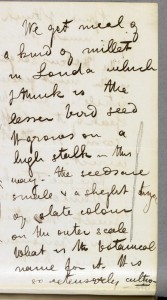 A blog post from Kew’s archivists on the Zambesi Expedition of 1858-1864 led me to Dr Livingstone’s papers, among which I stumbled on this wonderful letter to Joseph D. Hooker:
A blog post from Kew’s archivists on the Zambesi Expedition of 1858-1864 led me to Dr Livingstone’s papers, among which I stumbled on this wonderful letter to Joseph D. Hooker:
Hadley Green Barnet 11th July 1857
My Dear Dr Hooker
I beg to return you my hearty thanks for your note and the trouble you have been at in deciphering the mere fragments submitted to you. Your willingness to examine anything botanical will certainly make me more anxious to secure something for you in Africa more worthy of your time. We get meal of a kind of millet in Londa which I think is the lesser bird seed. It grows on a high stalk in this way. The seeds are small & a {slight tinge} of slate colour on the outer scale. What is the botanical name for it? It is so extensively cultiv-{ated} in Africa I think you must know. The Holcus Sorghum is the most general article in use. We speak of it as Caffre corn. Is that correct?
There are two kinds of Manioc. One sweet the other bitter & poisonous they are both mentioned in a work by Daniel on the West Coast but I have not that work nearer at hand than Linyanti so I beg to trouble you to tell me the proper names of the two species of Manioc, the Jatropha Manihot and –
As I am boring with questions. Have you the proper names for the melons which form such an important article of support on the Kalahari Desert and of one there which has the flavour of an apple. What is the name of the Palm which when the leaves are broken off gives the idea of it being triangular The ends of the leaf stalks stick on and give it the appearance referred to. A fruit mentioned at the end of Bowdich’s work with by the name Masuka was found by me in very large quantities. It is good. As it seems know can I have the proper name. Now please just attend or not to these questions as it is convenient – though I send them it is not because I think I have any claim on your time or attention – I am only putting you in the way of doing an act of charity to yours &c David Livingstone
Now, how to find the reply?
And with that, dear reader, I take my leave of you for about three weeks, which I will spend not too far, relatively speaking, from where Stanley found Livingstone. In fact, I should already be there…
Would it be Jatropha utilisima?
What’s amazing is that the decision to use Jatropha instead of Manihot was proposed as early as 1841 (a proposition by Steudel), so Dr Livingstone was quick to adopt a recent taxonomy…
In the same period of time (between 1841 and 1865), about 8 new “cassava” species were described… (but then the utilitarian view with M. dulcis and M. utilisima lasted long despite discovery of many close wild relatives).
Inumpu or Nyumbo are indigenous ‘potatoes’ referred to by Livingstone. I have several blogs about them:
1. https://dianabuja.wordpress.com/2012/11/17/inumpu-burundis-indigenous-potatoes-a-recipe/
2. https://dianabuja.wordpress.com/2010/08/10/native-potatoes-a-great-health-restorative-for-livingstone-18703.
3. https://dianabuja.wordpress.com/2010/07/30/livingstones-potatoes-in-the-21st-century/
Also there are several other entries in which I’ve written about the plant; links are given at the end of no. 3, above.
On Livingstone’s experiences with various cassava, see-
1. Cassava in Context: Views from the 19th Century, I of II
2. Cassava in Context: Views from the 19th Century, II of II
3. https://dianabuja.wordpress.com/2011/05/04/cassava-as-a-meat-preservator-1860s/
Let me know of any broken links.